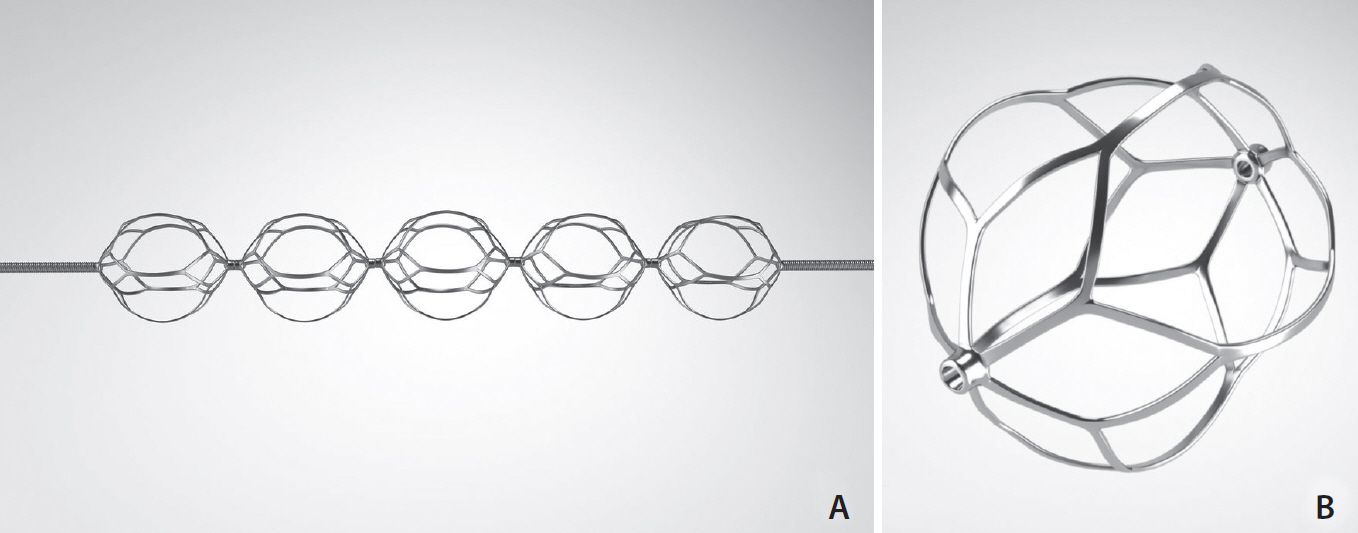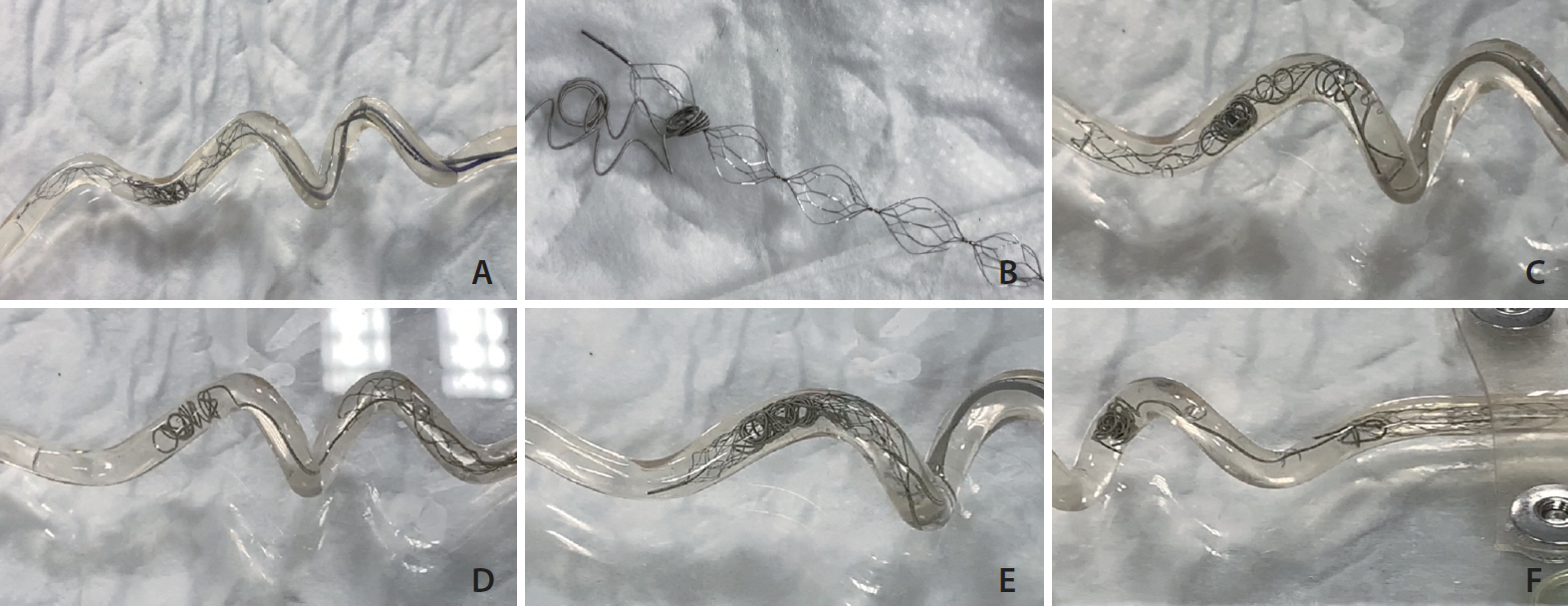Neurointervention.
2021 Jul;16(2):158-164. 10.5469/neuroint.2021.00066.
Rescue Maneuver of Migrated Coil Using the ERIC Device after Previous Attempts with Conventional Stentrievers
- Affiliations
-
- 1Interventional Neuroradiology/Endovascular Neurosurgery, Hospital Clínico Universitario de Valladolid, Valladolid, Spain
- 2Department of Neurosurgery, Hospital Clínico Universitario de Valladolid, Valladolid, Spain
- 3Department of Intensive Care, Hospital Clínico Universitario de Valladolid, Valladolid, Spain
- KMID: 2517741
- DOI: http://doi.org/10.5469/neuroint.2021.00066
Abstract
- Coil prolapse or migration is a rare but potentially serious complication that may occur during aneurysm embolization, with no standard management currently described. Here we describe our experience with the Embolus Retriever with Interlinked Cages (ERIC) device® (Microvention, Aliso Viejo, CA, USA) for the retrieval of prolapsed or migrated coils in a case series and Flow-Model analysis. First, a retrospective review was performed using our institution database for patients in which coil prolapse or migration occurred during aneurysm embolization, and data was collected and analyzed. Second, an in vitro Flow-Model analysis was performed comparing the ERIC device® with other stent retrievers for coil retrieval. In 2 cases, the ERIC device® successfully retrieved the displaced coil from intracranial circulation in 1 pass, after failure with other devices. In the Flow-Model, again the ERIC device® achieved success for retrieving a detached coil, whereas 2 other different stent retrievers failed to capture the coil after 2 attempts. The ERIC device® appears to be a safe and effective tool for retrieving a prolapsed or migrated coil from the intracranial circulation.
Keyword
Figure
Reference
-
1. Molyneux A, Kerr R, Stratton I, Sandercock P, Clarke M, Shrimpton J, International Subarachnoid Aneurysm Trial (ISAT) Collaborative Group, et al. International Subarachnoid Aneurysm Trial (ISAT) of neurosurgical clipping versus endovascular coiling in 2143 patients with ruptured intracranial aneurysms: a randomised trial. Lancet. 2002; 360:1267–1274.
Article2. Bradac GB, Bergui M, Stura G, Fontanella M, Daniele D, Gozzoli L, et al. Periprocedural morbidity and mortality by endovascular treatment of cerebral aneurysms with GDC: a retrospective 12-year experience of a single center. Neurosurg Rev. 2007; 30:117–125. discussion 125-126.
Article3. van Rooij WJ, Sluzewski M, Beute GN, Nijssen PC. Procedural complications of coiling of ruptured intracranial aneurysms: incidence and risk factors in a consecutive series of 681 patients. AJNR Am J Neuroradiol. 2006; 27:1498–1501.4. Borggrefe J, Behme D, Mpotsaris A, Weber W. Complications associated with cerebral aneurysm morphology in balloon-assisted coil embolization of ruptured and unruptured aneurysms-a single-center analysis of 116 consecutive cases. World Neurosurg. 2016; 91:483–489.
Article5. Leslie-Mazwi TM, Heddier M, Nordmeyer H, Stauder M, Velasco A, Mosimann PJ, et al. Stent retriever use for retrieval of displaced microcoils: a consecutive case series. AJNR Am J Neuroradiol. 2013; 34:1996–1999.
Article6. Vora N, Thomas A, Germanwala A, Jovin T, Horowitz M. Retrieval of a displaced detachable coil and intracranial stent with an L5 Merci Retriever during endovascular embolization of an intracranial aneurysm. J Neuroimaging. 2008; 18:81–84.
Article7. Lee CY. Use of wire as a snare for endovascular retrieval of displaced or stretched coils: rescue from a technical complication. Neuroradiology. 2011; 53:31–35.
Article8. Ding D, Liu KC. Management strategies for intraprocedural coil migration during endovascular treatment of intracranial aneurysms. J Neurointerv Surg. 2014; 6:428–431.9. Henkes H, Lowens S, Preiss H, Reinartz J, Miloslavski E, Kühne D. A new device for endovascular coil retrieval from intracranial vessels: alligator retrieval device. AJNR Am J Neuroradiol. 2006; 27:327–329.10. Zhou KZ, Maingard J, Kok HK, Wang J, Barras CD, O’hare A, et al. Endovascular retrieval of dislodged neurovascular devices with a stentriever: case series and technical review. World Neurosurg. 2019; 123:e661–e669.
Article11. Kabbani MR, Smith A, Leider M. Endovascular coil retrieval using a TrevoProVue stentriever. J Neurointerv Surg. 2015; 7:e19.
Article12. Nas OF, Kacar E, Kaya A, Erdogan C, Hakyemez B. Retrieval of a dislocated coil and stent-assisted coiling by Solitaire® stent during endovascular treatment of an intracranial aneurysm. Diagn Interv Imaging. 2016; 97:381–384.13. Amuluru K, Al-Mufti F, Romero CE. Endovascular retrieval of migrated coil within the distal middle cerebral artery using stentriever device. World Neurosurg. 2018; 117:382–385.
Article14. Nikoubashman O, Pjontek R, Brockmann MA, Tolba R, Wiesmann M. Retrieval of migrated coils with stent retrievers: an animal study. AJNR Am J Neuroradiol. 2015; 36:1162–1166.
Article15. Simgen A, Tomori T, Mühl-Benninghaus R, Bomberg H, Yilmaz U, Körner H, et al. Retrieval of migrated volume coils using different clot retrievers in a porcine model. Clin Neuroradiol. 2018; 28:593–600.16. Ducroux C, Renaud N, Bourcier R, Marnat G, Sibon I, Gory B, ETIS investigators, et al. Embolus Retriever with Interlinked Cages (ERIC) versus conventional stent retrievers for thrombectomy: a propensity score-based analysis. J Neurointerv Surg. 2021; 13:255–260.
Article17. Edwards NJ, Jones WH, Sanzgiri A, Corona J, Dannenbaum M, Chen PR. Antiplatelet therapy for the prevention of peri-coiling thromboembolism in high-risk patients with ruptured intracranial aneurysms. J Neurosurg. 2017; 127:1326–1332.
Article
- Full Text Links
- Actions
-
Cited
- CITED
-
- Close
- Share
- Similar articles
-
- Migrated coil and damaged stent removal during coil embolization, using an additional, retrievable stent: A case report
- Rescue Therapy of Inadvertent Coil Migration for Endovascular Treatment of Type II Endoleak
- Endovascular Rescue Method for Undesirably Stretched Coil
- Management of a Complicated Cerebral Aneurysm with Distal Migration of a Detachable Coil: A Case Report
- Retrieval of Distally Migrated Coils with Detachable Intracranial Stent during Coil Embolization of Cerebral Aneurysm





